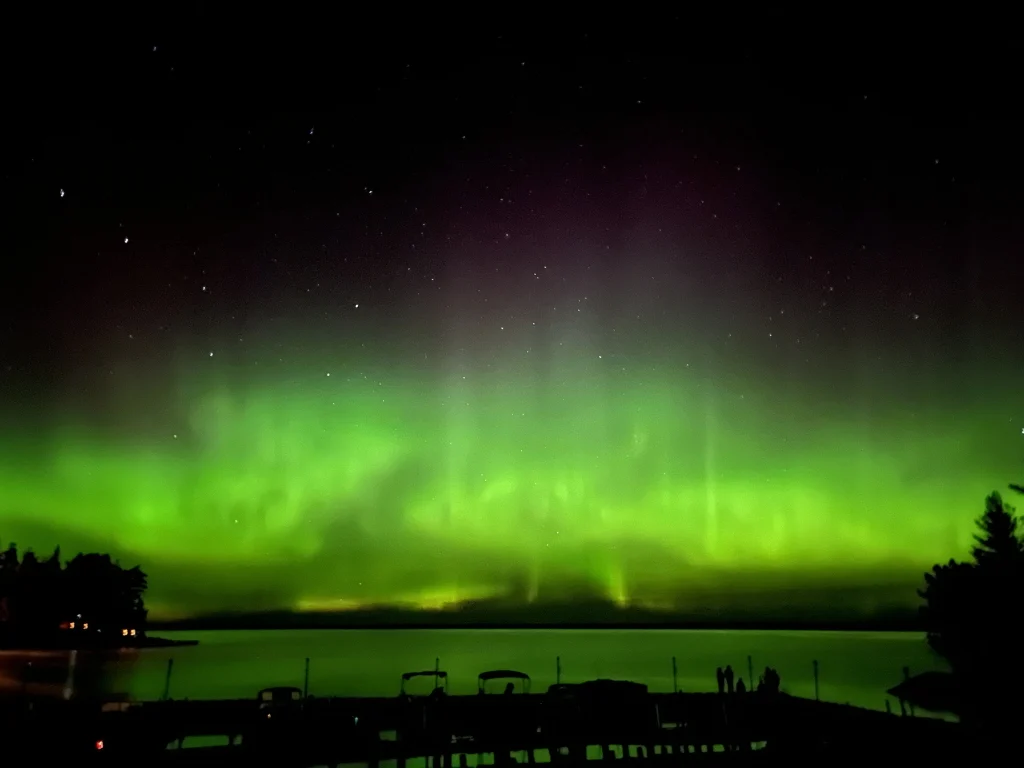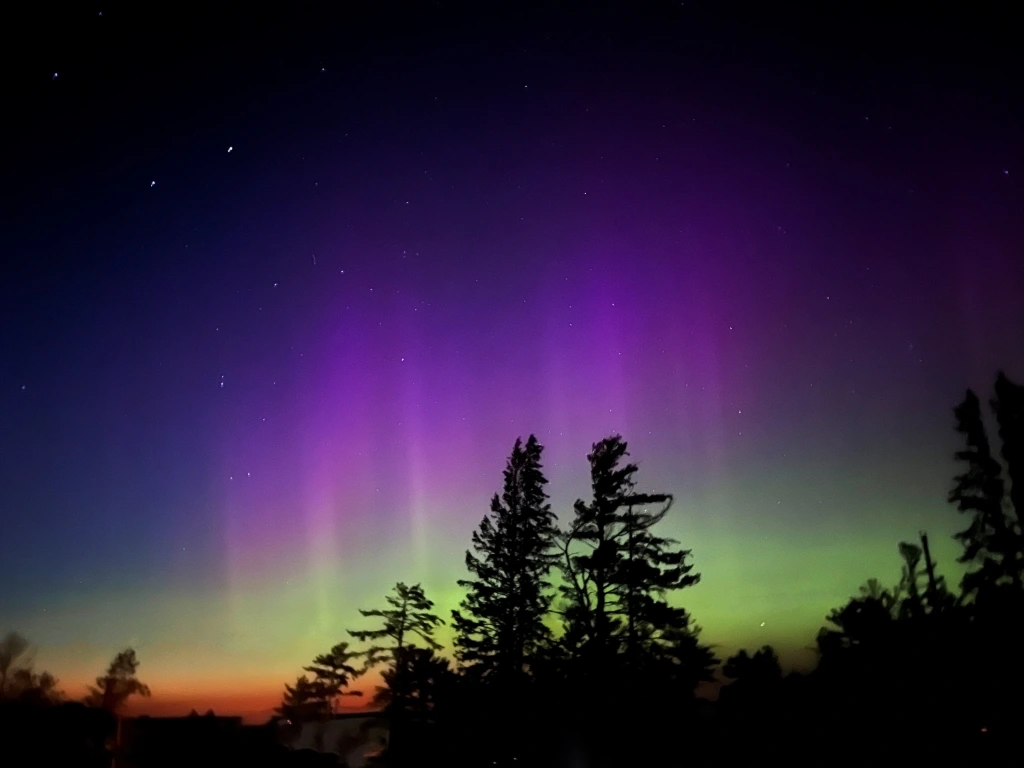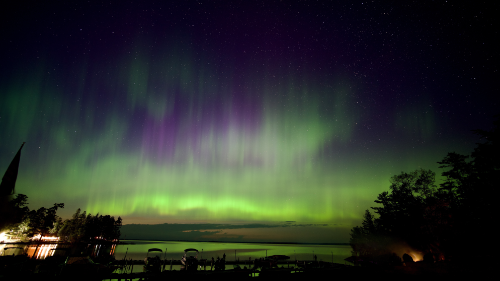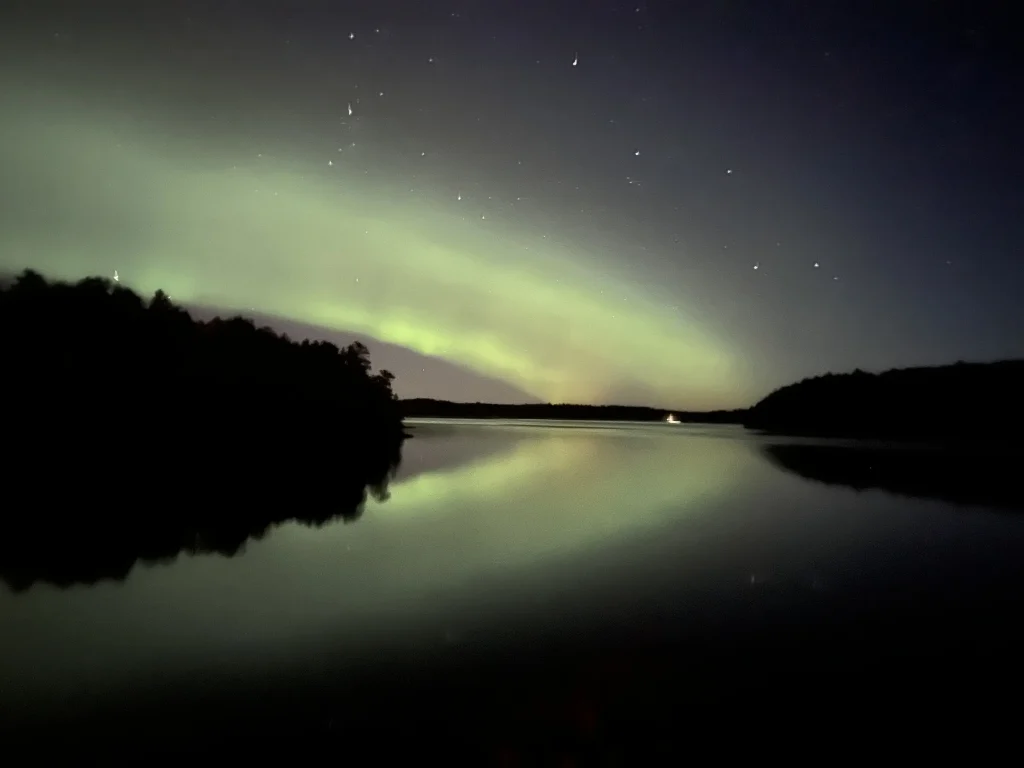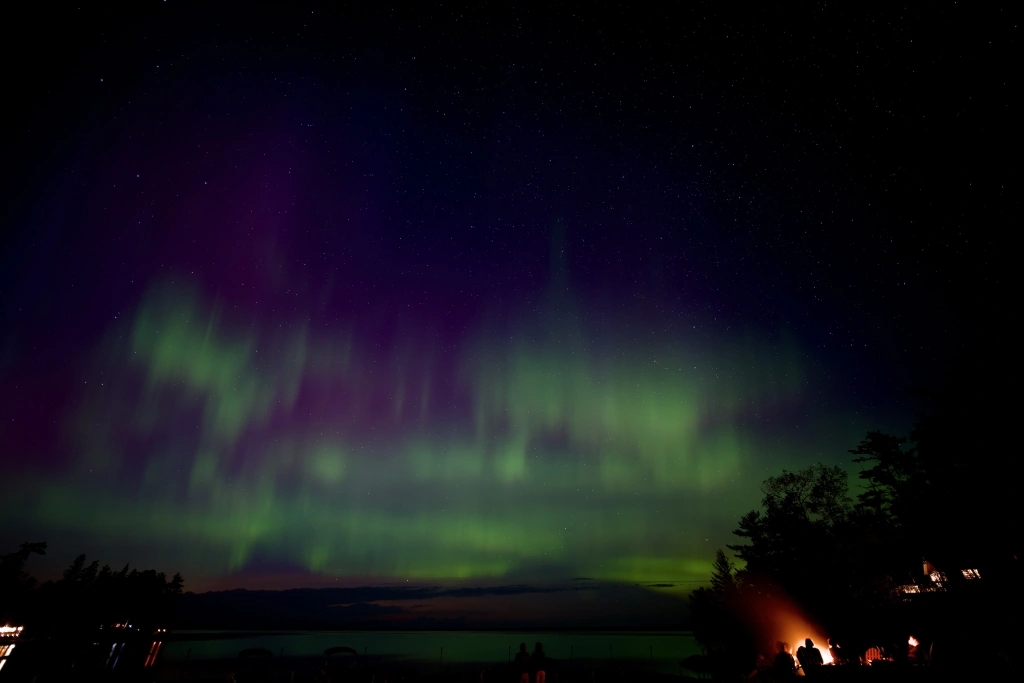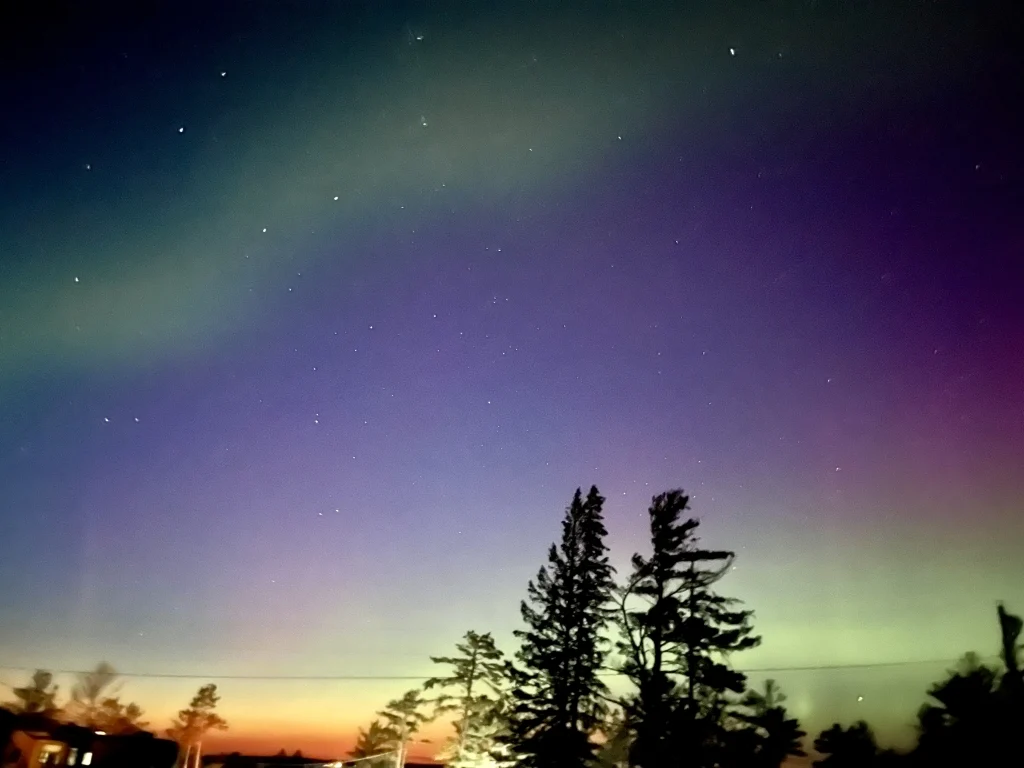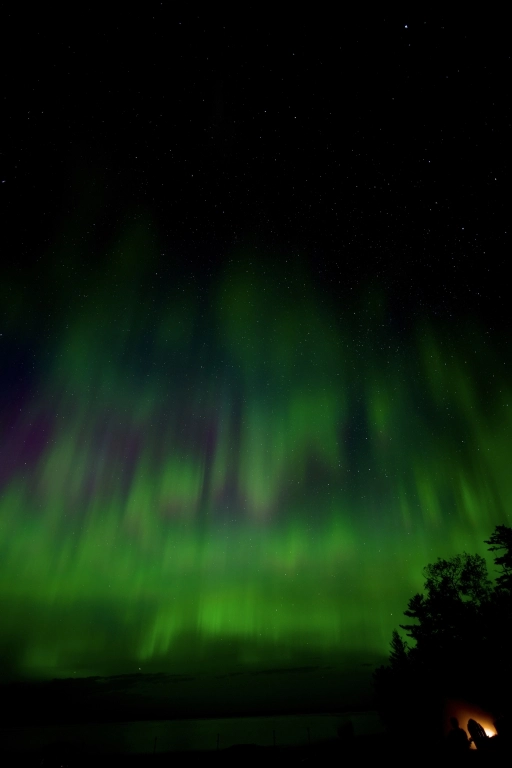Table of Contents
All About The Minnesota Northern Lights
If you’re planning a trip to see the Minnesota Northern Lights and hoping to catch a glimpse of the stunning natural phenomenon, you’re in luck! Minnesota is known to be one of the best places in the world to see this awe-inspiring display of colorful lights dancing across the night sky. Selected as one of the 10 best Northern Lights hotels in the US, there is no better lodging than The Pines of Kabetogama to experience them.
Why is Voyageurs National Park the Best Place in Minnesota to See the Northern Lights?
Voyageurs National Park, home to The Pines of Kabetogama Resort, is widely recognized as the premier location in Minnesota to witness the spectacular Aurora Borealis. Its unique positioning at a northern latitude, combined with exceptionally dark skies free from urban light pollution, provides optimal conditions for Northern Lights viewing. Recognized officially as an International Dark Sky Park, Voyageurs offers visitors unparalleled opportunities—approximately 100 nights per year—to experience vivid displays of auroral activity, far exceeding the frequency available elsewhere in the state.
Located directly on the shores of Lake Kabetogama, The Pines of Kabetogama enhances your Northern Lights experience with unobstructed, panoramic views facing north—the ideal direction for aurora observation. Guests often marvel at the sight of the Northern Lights reflecting off the serene waters of the lake, creating unforgettable, picture-perfect moments. Whether you’re a seasoned aurora enthusiast or hoping to catch your first glimpse, The Pines’ lakeside cabins and RV sites place you in the heart of Minnesota’s best aurora viewing environment, providing both comfort and convenience beneath a breathtaking celestial show.
All of these Minnesota Northern Lights photos were all captured by resort staff and guests at The Pines of Kabetogama
When are the Minnesota Northern Lights Visible?
The Northern Lights, also known as the Aurora Borealis, can be visible in Minnesota all year long. The frequency of seeing the Northern Lights in Minnesota varies each year, but on average, the Aurora can be visible about 75-100 times per year. That’s better than a 1-in-5 chance each day of the year! The timing is right, as we ramp up to solar cycle 25 maximum, which is most likely to take place in July, 2025.
It is important to note that seeing the Northern Lights is never guaranteed, and visibility is dependent on three primary factors:
- Solar Weather Forecast
- The higher the Kp number, the larger the Aurora
- Moon Phase
- New Moon = No Moon = Dark Skies
- Celestial Events Schedule
- Clear Night Skies
- Fingers crossed Mother Nature cooperates
It’s always a good idea to check the forecast and because the sun sets later in the evening in the summer months plan to stay up a little bit later than usual. Trust that it will be worth it even if you don’t see the Northern Lights.
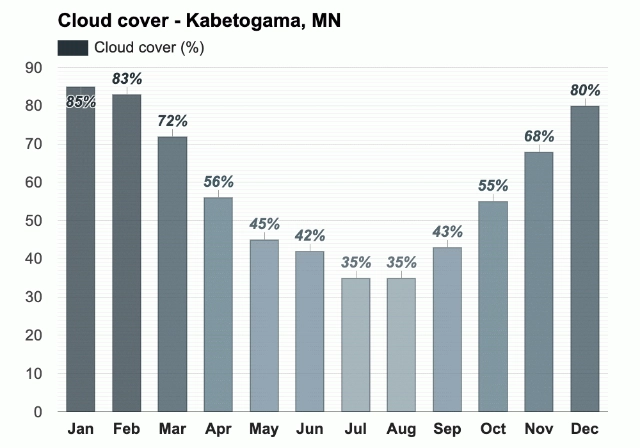
If you’re planning to experience the awe-inspiring Minnesota Northern Lights, you might think winter is the best season. However, as the cloud cover chart above shows, the clearest skies in Kabetogama, MN, occur between May and October, making summer and early fall ideal for Northern Lights viewing. These months feature significantly less cloud coverage compared to the winter season, offering better visibility for stargazing and celestial events. Explore the breathtaking night skies at The Pines of Kabetogama, located within Voyageurs National Park, where the reduced cloud cover enhances your chances of witnessing nature’s spectacular light show.
Voyageurs National Park, located in northern Minnesota, is known for its pristine and dark night skies, and is a certified International Dark Sky Park, making it an ideal place to view the Northern Lights. The park is far from major urban areas, which helps minimize light pollution.
To preserve the natural darkness of the night sky, The Pines of Kabetogama has implemented measures to reduce light pollution, such as using motion sensors and timers for outdoor lighting and encouraging visitors to use red light flashlights instead of regular white light flashlights when exploring the park at night. Additionally, Voyagers National Park offers stargazing programs and educational resources to promote awareness of the importance of preserving dark skies for the benefit of wildlife and human health.
How do I check the Minnesota Northern Lights Forecast?
- The first place we look for the forecast is a smartphone phone app called My Aurora Forecast.
- The second place we look is the Soft Serve News Aurora Alerts website.
- Third is SpaceWeather.com
How do I know if I am seeing the Minnesota Northern Lights?
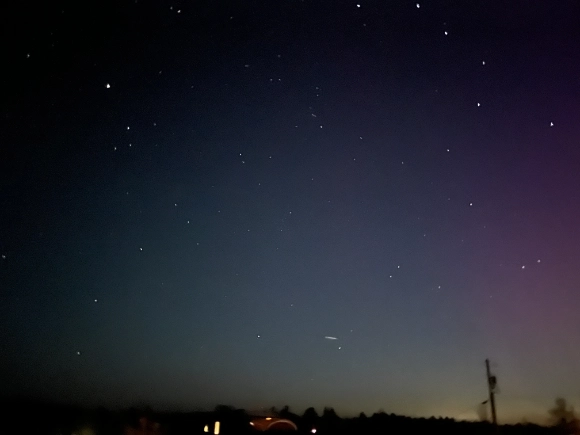
If the forecast looks good, keep your eyes on the northern horizon. The Pines of Kabetogama are located on the south shore of Kabetogama LAke with an absolutely perfect view of the northern sky. Our expansive front lawn is a great place to settle in with an unobstructed view of the horizon.
Be aware that during summer, the onset of a Northern Lights show may be subtle. Some guests have mistaken it for fog, clouds, or even light pollution (which is not the case!). If you aren’t quite sure what you are looking at, snap a few photos, the camera will capture the colors before you can see them with your eyes, or check back again in 30 minutes. Don’t forget to share your stories and photos, we absolutely LOVE it when our guests have an unforgettable night sky experience at our resort.
How do I take pictures of the Minnesota Northern Lights?
iPhone
How to Photo Shoot The Northern Lights With Your iPhone – Aurora Borealis
The Night Mode feature on iPhone automatically turns on in low-light conditions and keeps the camera sensor open for a longer time to capture more detail in the image, known as long exposure. To capture Northern Lights, adjust the exposure time to the maximum of 30 seconds using the hidden Night Mode settings menu. If the environment is too bright, use Exposure Adjustment to prevent overexposure. Experiment with different values to find the best setting for your surroundings.
Android
How to capture the northern lights on your smartphone
To take photos of the northern lights using a smartphone, turn on the “night mode” feature and hold the phone horizontally. Use the camera’s pro or manual mode, and activate the ‘MF’ icon on an Android device. Turn off the flash and set the ISO to 1600 or higher. Set the white balance to around 3200K. Adjust the shutter speed depending on the brightness of the aurora. Keep the camera as still as possible to avoid blurriness.
What causes the Northern Lights?
Discovered by Christian Birkeland in 1896, the true origin of the Northern Lights lies in Earth’s magnetosphere, shielding against solar wind’s charged particles. Interaction at the poles creates the colorful display, as electrons from the solar wind excite oxygen and nitrogen atoms, releasing vibrant photons. Colors vary with altitude, forming pink, purple, and white lights. Most visible during solar storms, the Northern Lights are overshadowed by sunlight during the day.
What is the KP Index?
To witness the Northern Lights, aim for a KP forecast of 4 or higher. The KP Index, measuring geomagnetic activity on a scale of 0 to 9, indicates a greater chance of Northern Lights at lower latitudes with higher numbers. Derived from the solar wind’s strength and direction, the KP Index guides predictions by scientists and space weather forecasters for the Aurora Borealis display resulting from the interaction between the solar wind and Earth’s magnetic field.
The KP Index is calculated based on measurements of the Earth’s magnetic field taken at several magnetic observatories around the world. These measurements are used to calculate a single “planetary” value of the magnetic activity level, known as the Kp index.
The Kp index is calculated using a complex algorithm that takes into account several different measures of the Earth’s magnetic field, including the magnetic variations (D component) recorded by ground-based magnetometers at various locations around the world. These measurements are combined to determine the Kp value, which ranges from 0 to 9, with higher values indicating a higher level of magnetic activity.
In addition to the Kp index, other measures of magnetic activity such as the A, Ap, and Cp indices may also be used to assess the likelihood of geomagnetic disturbances and the potential for auroral displays such as the Northern Lights.
Other factors that can influence the KP index include solar wind speed, solar wind density, and the direction of the interplanetary magnetic field. By monitoring these variables and combining them with the measurements of the Earth’s magnetic field, scientists and space weather forecasters can make predictions about the likelihood of seeing the Northern Lights in a given location at a particular time.
What is the Solar Cycle?
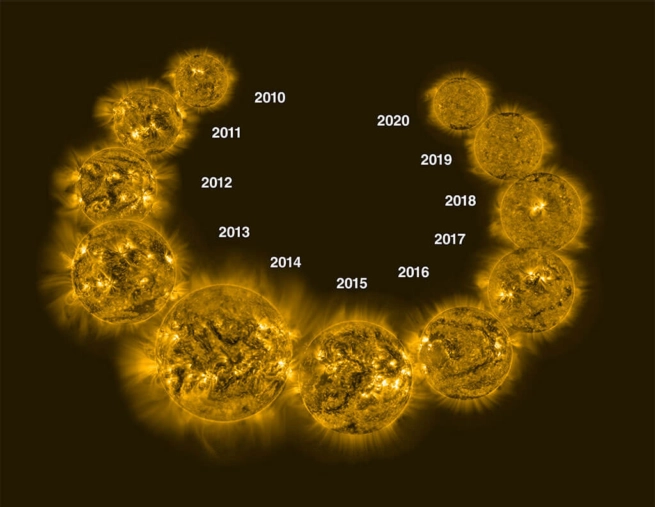
The sun is currently experiencing Solar Cycle 25. Solar Cycle 25 is already exceeding predictions, and solar events will continue to increase and intense Minnesota Northern Lights are predicted as we near solar maximum, most likely to take place in July, 2025.
The solar cycle, also known as the sunspot cycle, is a natural and periodic variation in the Sun’s activity that occurs over an average period of about 11 years. This cycle is characterized by the number and intensity of sunspots, as well as the frequency and intensity of solar flares and coronal mass ejections (CMEs).
During the solar cycle, the Sun undergoes a series of changes that affect the entire solar system. At the beginning of each cycle, the Sun is relatively quiet, with few sunspots or solar flares. As the cycle progresses, the number and intensity of sunspots and solar flares increase, reaching a maximum at the cycle’s peak. After the peak, the activity gradually decreases, eventually returning to a minimum level before the next cycle begins.
The solar cycle is believed to be driven by the Sun’s magnetic field, which becomes increasingly complex and twisted over the course of the cycle. This leads to the formation of sunspots, which are areas of intense magnetic activity that appear as dark spots on the Sun’s surface. As the magnetic field continues to evolve, sunspots can become more numerous and intense, leading to increased solar activity.
The solar cycle has important implications for a wide range of phenomena, including space weather, climate, and communication systems. Understanding and predicting the solar cycle is an active area of research, and scientists use a variety of techniques to monitor and study the Sun’s activity.
Solar Wind
What are solar wind speeds?
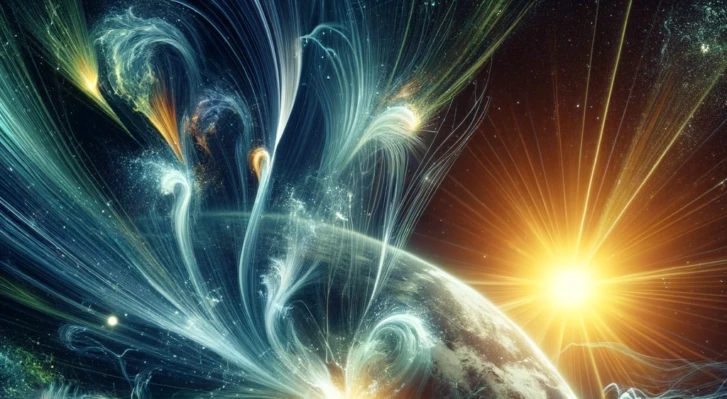
Solar wind speed is one of the factors that can affect the KP Index. When the solar wind is faster or denser than normal, it can cause more geomagnetic disturbances, which in turn can lead to a higher KP Index and an increased likelihood of seeing the Northern Lights at lower latitudes. Conversely, when the solar wind is slower or less dense, the KP Index may be lower, and the chances of seeing the Northern Lights may be reduced.
What is solar wind density?
Solar wind density is another factor that can influence the KP Index. When the density of the solar wind is higher than normal, it can compress the Earth’s magnetic field, which can increase the likelihood of geomagnetic disturbances and lead to a higher KP Index. Conversely, when the solar wind density is lower than average, the Earth’s magnetic field may not be as compressed, which can result in a lower KP Index and decreased chances of seeing the Northern Lights at lower latitudes. Solar wind density is just one of several factors that can affect the KP Index, along with solar wind speed, interplanetary magnetic field direction, and other variables.
What is Bz?
Solar Wind Bz (pronounced “bee sub zee”) is a component of the interplanetary magnetic field (IMF) that can influence the KP Index and the likelihood of seeing the Northern Lights. The IMF is a magnetic field that originates from the Sun and is carried by the solar wind as it flows through space. Solar Wind Bz specifically refers to the component of the IMF that is aligned with the Earth’s magnetic field, and can therefore have a strong effect on geomagnetic activity.
Solar Wind Bz influences geomagnetic activity. Southward orientation intensifies interaction with Earth’s magnetic field, raising the KP Index and the chance of geomagnetic disturbances. In contrast, northward orientation reduces interaction, leading to lower geomagnetic activity and a decreased KP Index. Monitoring Solar Wind Bz aids scientists in predicting Northern Lights visibility.
What is Bt?
Solar Wind Bt (pronounced “bee tee”) refers to the total strength of the interplanetary magnetic field (IMF), which can also affect the KP Index and the likelihood of seeing the Northern Lights. The IMF is a magnetic field that originates from the Sun and is carried by the solar wind as it flows through space.
Solar Wind Bt is one of several factors that can influence the interaction between the solar wind and the Earth’s magnetic field. When the total strength of the IMF is high, it can compress the Earth’s magnetic field, leading to an increased likelihood of geomagnetic disturbances and a higher KP Index. Conversely, when the total strength of the IMF is low, the Earth’s magnetic field may not be as compressed, resulting in lower levels of geomagnetic activity and a lower KP Index.
However, it’s important to note that Solar Wind Bt is just one of several variables that can affect the KP Index, and the complex interactions between the solar wind and the Earth’s magnetic field can be difficult to predict with precision. Therefore, scientists and space weather forecasters use a variety of measurements and models to make their predictions about the likelihood of seeing the Northern Lights in a given location at a particular time.
What time to see the Northern Lights in Minnesota tonight?
The best time to see the Northern Lights in Minnesota is typically between 10 PM and 2 AM. Check local aurora forecasts to determine the exact timing for tonight.
What time is best for Northern Lights tonight?
The peak time for viewing the Northern Lights is usually around midnight, between 10 PM and 2 AM. For the most accurate timing, consult aurora forecast tools for tonight’s activity.
Are there Northern Lights in Minneapolis?
While it is rare to see the Northern Lights in Minneapolis due to light pollution, strong solar activity can occasionally make them visible in the city. For better chances, travel to darker areas in northern Minnesota.
Which direction to look for the Northern Lights?
To see the Northern Lights, look toward the northern horizon. The further north you are, the higher they will appear in the sky.
What is the best exposure time for the northern lights?
For photographing the Northern Lights, use an exposure time of 5 to 25 seconds. This will capture the aurora’s movement and colors effectively.
How long do the Northern Lights last?
The duration of the Northern Lights can vary from a few minutes to several hours, depending on solar activity. They often appear in waves, so be patient and keep watching the sky.
How to see the Northern Lights in Minnesota?
To spot the Northern Lights, head to a dark location away from city lights, look to the north, and keep an eye on aurora forecasts. Clear skies and high solar activity increase your chances.
Where is the best chance to see the Northern Lights in MN?
The best chance to see the Northern Lights in Minnesota is in the northern regions, particularly around Voyageurs National Park, Lake Kabetogama, and the Boundary Waters Canoe Area.
What National Park in Minnesota can you see the Northern Lights?
Voyageurs National Park is one of the best places in Minnesota to see the Northern Lights due to its location in the northern part of the state and its designation as an International Dark Sky Park.
What not to do with Northern Lights?
When viewing the Northern Lights, avoid using bright lights, including flash photography, as this can diminish your night vision and the experience for others.
What is the etiquette for Northern Lights?
When viewing the Northern Lights, be considerate of others by minimizing light pollution, keeping noise levels down, and sharing the best viewing spots. Respect nature and leave no trace.

